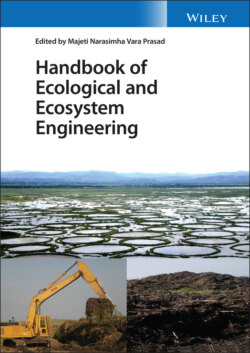Читать книгу Handbook of Ecological and Ecosystem Engineering - Группа авторов - Страница 33
2.5 Conclusions
ОглавлениеEcological engineering encompasses a variety of physical and chemical remediation technologies and, together with ecosystem engineering technologies such as bioremediation, dendroremediation, mycoremediation, and phytoremediation (and associated technologies), can be successfully applied to modify, restore, maintain, and/or (re‐)create functional ecosystems on marginal and degraded land. The joint application of approaches can result in more effective land recovery and restoration than using them separately.
Given soil cracking and low soil drainage, ecological engineering techniques such as microbially induced calcite precipitation, compaction control, surcharge loading, geogrids, and plant root reinforcement can reduce soil cracking. Super‐absorbent polymers can promote water uptake and utilization in sloping areas, which can optimize irrigation water schemes in regions affected by drought, erosion, and desertification. Extracted washing, electrokinetic remediation, chemical oxidation, nanomaterial remediation, adsorption, filtration, granular activated carbon, and photocatalysis are physical and chemical technologies that can effectively remove and stabilize heavy metals from marginal and degraded soils by changing the pH, moisture content, or oxidation potential. All these technologies can be applied efficiently to improve marginal lands; but when applied alone, they usually affect and can even stop soil functions.
Together with ecological engineering approaches, ecosystem engineering and, specifically, phytoremediation can further reduce soil constraints and promote the development of ecological functions. Under soil‐cracking conditions, introducing perennial energy crops can accelerate the decomposition of organic matter available in soil (incorporated, for example, via biosolids and other organic amendments), increasing soil aeration and fertility. These perennial crops can stabilize the soil's physical structure and promote soil organic carbon storage. They can also adapt to a variety of clay textures and promote the balance between water and gases in different soil types, including stony soil. This can be an essential aspect of soil management and restoration, especially for soils prone to drought and affected by salinization. Other industrial crops like V. zizanoides, sorghum, giant reed, and perennial ryegrass can also promote soil remediation given waterlogging or cold conditions, showing high tolerance to a huge range of environmental conditions. Many of the perennial crops used for bioenergy purposes produce high yields and fast growth at the same time, which can stimulate fungal and microorganism communities that help restore physical and chemical constraints in soils. In sloping areas, perennial crops like giant reed, switchgrass, Miscanthus spp., and P. purpureum can reinforce soil aggregates and provide support, increasing cohesive and adhesive forces and reducing susceptibility to erosion and landslides. The same crops can remove and immobilize the toxicological effect of heavy metals, other salts, and inorganic and emergent contaminants that reach the soil environment, providing a very efficient and cheap means to restore soil and improve soil conditions for the development of soil microorganisms, fungi, and other soil biota while also generating biomass for the bioeconomy (bioenergy, fiber, and other bio‐products).
